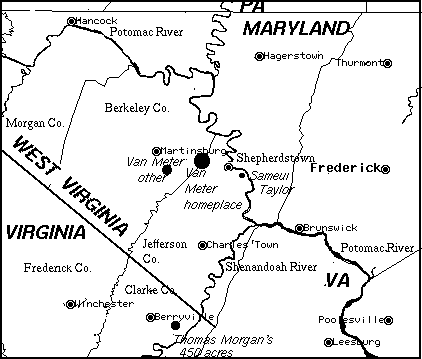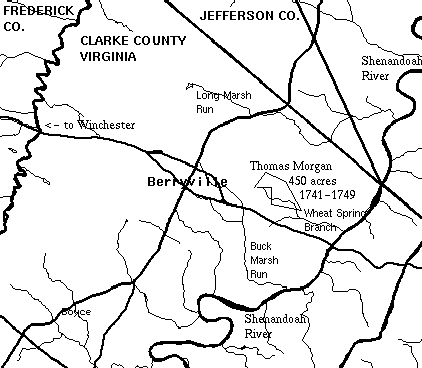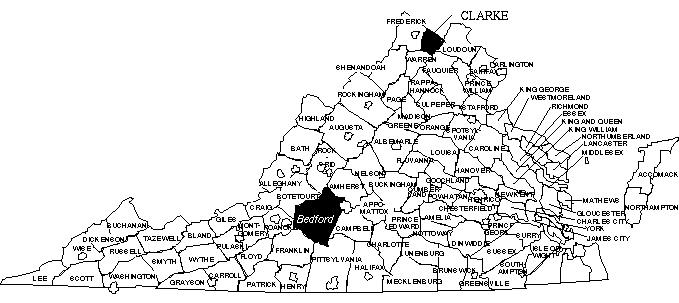

|--------
|
|---------James MORGAN (1645, Great Britain - 1691, Maryland)
| |
| |--------
|
|------Lewis MORGAN ( - )
| |
| | |--------
| | |
| |---------Jane (Wales - 1691, crossing the sea)
| |
| |--------
|
Thomas MORGAN (1702 - 1774, VA)
|
| |--------
| |
| |---------
| | |
| | |--------
| |
|------Elizabeth ( - )
|
| |--------
| |
|---------
|
|--------
The starting point for tracing Thomas Morgan back to the time before he arrived in Bedford County comes from a deposition Thomas made in 1770 in the Hite vs. Fairfax land suit. Thomas states that he purchased 450 acres on the Shenandoah River referred to in the court case as Arnold's Branch tract. On November 2, 1749, he sold that land for 120 pounds to Bartholomew Anderson, for which Thomas took a negro named Jack for sixty some odd pounds and a wagon at twenty pounds and the rest to be paid in cash. He states he is a blacksmith, and the farm contains a house, outhouse, grist mill, and fruit trees. There is no statement that his wife relinquished her dower; therefore at this time he was a widower.
This 450 acres is in the northeast of what is now Clarke County, Virginia. Clarke County was formed from Frederick Co. The Arnold's Branch waterway is also called the Wheat Spring Branch. Thomas Morgan purchased the 450 acres from Abel Pearson. It had been surveyed in 1735 for Jost Hite, the leader of early Virginia settlement who would have sold the land to Pearson.
I've been told that this land was surveyed in 1751 by George Washington.
In other evidence gathered for the Hite v. Fairfax land suit, it is stated that Thomas arrived in 1735 and purchased land that was originally in the Van Meter Grant. This, with the aid of other land records, allows us to reconstruct Thomas' path across Virginia. The earliest record at a court house is in 1741 in Orange County, Virginia (which changed to Frederick County, Virginia in 1743) where Thomas Morgan registered his ear-mark.
%


% The above pair of maps show where Thomas Morgan lived, taken from information and maps in O'Dell's Frederick County history.
%The first shows several counties in Northern Virginia, including the area where Thomas Morgan first moved in 1735. John Van Meter had two large personal holdings near each other, shown with black dots on the map. Van Meter's home was on 1786 acres on what is now the Berkeley-Jefferson county line in West Virginia, and he had several hundred acres two or three miles to the west of his home. Thomas Morgan moved to the area of the Van Meter Grant in 1735, which was a much larger (40,000 acres) area, but probably included the land which Van Meter took for his own usage. % The second map shows a closeup detail of the Thomas Morgan holding which he bought in 1741 and sold in 1749.
%
% 
Here
is a modern county outline map of Virginia, with
Clarke and Bedford counties highlighted. Remember that
Bedford County once encompassed all the counties south of it as well.
%
Thomas remarries in 1750 and moves with his family and sons to Lunenburg County, Virginia. ``Thomas Morgin, Thomas Morgin, Junr., and Lewis Morgin'' are on a list of Tithes for Lunenburg county in the part of the county west of Goose Creek (Goose Creek runs roughly through the center of what is now Bedford County).
Thomas purchased 620 acres in newly formed Bedford County on Sept. 10, 1755, along Hunting Creek in the present area of Moneta, Virginia. (Bedford County was formed out of Lunenburg County. Moneta is near the southern tip of modern Bedford County.)
Thomas continued to purchase land; June 1763: 243 acres; June 1763: 396 acres; September 1764: 400 acres in Bedford County. In addition to farming he continues the trade as a miller. For unknown reasons, Indians did not like mills; his first mill was burnt by Indians who turned on the mill machinery when there was no grain to be ground and friction from the mill stones rubbing together set the building on fire. A second mill was built near the site of the first mill. He died in 1774, it is said he was killed by an arrow while standing in the mill door.
On May 8, 1758, Thomas Morgan, along with Christian Choat and Jacob Biborn of Bedford County, Virginia, wrote a letter to George Washington describing an Indian raid in Bedford County. This letter is preserved with other Washington papers in the Library of Congress. Here is it's text:
A merandom of what of what we the supcribers have seen by the indins when we come to the house we saw a indin with a knife in his hand gun acting as tho he had a mind to kill us and went out and gave a hallow and then several more apeard and he returnd in again and took my gun and took site at my face and the rest Jumpt of their horses with their guns and knives dran in their hands and hallowing and runing as fast as they could to the hous and when we told them they should not doe so they with their knives opened to stab us so we maid off as fast as fast as we could and we heard them braking open the chests as we took it to be as witnes our hands. THOMAS MORGAIN, JACOB DILINN, CHRISTIAN CHOAT
According to Phebe Morgan and Melvin Scott, there is now a water treatment plant now where Thomas Morgan's Bedford County grist mill used to be.
Phebe Morgan (wife of a descendent of Thomas' son Lewis and then Lewis' son Thomas) has done a lot of work to trace Thomas Morgan prior to his arrival in Virginia. To understand this, you have to learn a little about the history of settlement of Virginia. The area west of the Blue Ridge Mountains in Virginia wasn't settled at all until just before 1730 when people began coming across the shallow Potomac River from Maryland. In 1730, the Colony of Virginia began encouraging settlement in these western territories. Jost Hite, John Van Meter, Robert McKay and others were given large grants of land in the Shenandoah and Potomac Valleys. These were sold to and settled by at least one family per 1000 acres. The new settlers were drawn from nearby areas in Pennsylvania, Maryland and Delaware. A later dispute with Lord Thomas Fairfax over Hite's right to the land granted him led to the Hite/Fairfax lawsuit which provided documentation of Thomas Morgan's earlier life.
Jost Hite recruited the first settlers from the Quaker community of Chester County, Pennsylvania. A Thomas Morgan appears on the tax lists of London Britain Township, Chester County, Pennsylvania in 1725. The rate he was taxed indicate he was married. He is living next to a Lewis Morgan also taxed as a married man. Lewis and Thomas continue on the tax rolls through 1734. In 1734 there are additionally listing of a Morgan Morgan (married), and John Morgan (single). As of 1735, Thomas Morgan is no longer listed there, but John, Lewis and Morgan continue on the tax rolls until at least 1740. (Recall that 1735 is the year that Thomas Morgan also arrived in Virginia.)
The below division of children between the two wives of Thomas Morgan is somewhat arbitrary. Some of the children's birthdates were taken from the LDS AF database, and appear to have been just made up for that. I am pretty sure that Lewis, Thomas, Elizabeth, and Leatice definitely belong with the first wife.
An alternative set of parents for Thomas is given in papers (modern-day family research) written by a Marjorie Slater and deposited at the Bedford County library. I learned of this information from another Morgan family researcher, Thelma Sylvester. According to Thelma's letter, these library records don't give any sources for their assertions. The library records say that Thomas' parents were Isaac and Leatice Morgin and that Thomas and Isaac were both born in Glamorgan, Wales.
This is not the interpretation I give here for Thomas' parents, but I thought I should mention it as an alternative theory.
Sources for this individual: @S807@ @S234@ @S808@ @S612@ @S809@ @S233@ @S810@